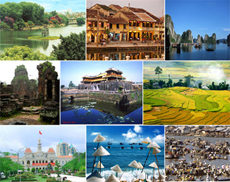Vietnam's tourism sector continued to overcome difficulties in 2012 in order to achieve its goals. The tourism sector has been proactive in promoting the image of the country to the world through websites and satellite together with the participation of the international media. Vietnam has been seen as a new attractive, safe and friendly destination.
 According to the 2012 national tourism promotion program, the tourism sector basically achieved its goals in building a new image, such as promoting Vietnamese tourism in foreign countries; advertising tourism through major events, information channels and the media; researching and surveying the establishment of Vietnam's representative offices specializing tourism in Japan; organizing tourism promotion programs; strengthening the publication of tourist printed materials; creating a database and tourism information service for tourism promotion activities; improving staff capacity in tourism offices; and diversifying tourism products.
According to the 2012 national tourism promotion program, the tourism sector basically achieved its goals in building a new image, such as promoting Vietnamese tourism in foreign countries; advertising tourism through major events, information channels and the media; researching and surveying the establishment of Vietnam's representative offices specializing tourism in Japan; organizing tourism promotion programs; strengthening the publication of tourist printed materials; creating a database and tourism information service for tourism promotion activities; improving staff capacity in tourism offices; and diversifying tourism products.
One of the most important contributions to these successes was tourism promotion programs through the international media and websites. In addition, promotion activities by the Ministry of Culture, Sports and Tourism and Vietnam's tourism ambassadors in international countries, such as South Africa, the Philippines and France have brought positive results. International TV channels and magazines have been active in promoting Vietnamese tourism, such as VCTV's Travel Channel, the BBC, Japan's Mainichi Broadcasting System, Holland's BNN and the Lonely Planet Traveller magazine. In addition, other channels have made programs to introduce Vietnam's image and tourism potential, contributing to advertising Vietnamese tourism to international tourists.
Food is another distinct feature contributing to create impression for Vietnam's tourism sector in the eyes of international tourists. It is seen as an effective information channel that has been exploited and promoted by the tourism sector. Vietnamese food has been heavily covered in recent times. One of the most effective ways to introduce Vietnamese food to overseas Vietnamese is via VTV. According to the State Committee for Overseas Vietnamese, Vietnam currently has about 4.5 million people living and working in 104 countries and territories. In the integration process, overseas Vietnamese play an important role in promoting the cultural national character in a practical and effective way. Therefore, advertising tourism image and Vietnamese food to those communities has contributed to create a foundation in order to ensure the sustainable development of the tourism sector. 12 Vietnamese food bearing ASEAN culinary value were recognized by international organization, such as Pho, Hanoi noodles and grilled meat, HCMC broken rice, Hai Phong crab dry pancake, Hue beef noodle soup, Vung Tau cake and Gia Lai dry noodles. This is an effective method to attract international tourists to Vietnam. International tourists traveling to Vietnam can explore the natural landscape and enjoy Vietnamese food.
Vietnam's tourism sector has focused on upgrading tourism infrastructure and tourist routes in almost all localities in the country. The Vietnam National Administration of Tourism called on localities to pay more attention to the construction and upgrading of tourist destinations. In addition, travel businesses have been active in training and improving capacity and the quality of tourist guides in specialist skills and foreign languages. Through effective monitoring, the expansion of joint training programs in localities throughout the country has gradually been improved and acknowledged by domestic and international tourists. Together with policies focusing on unique village products, the diversification of tourism products has also implemented. In particular, the Hanoi UNESCO cooperated with Quang Nam People's Committee to launch a project focusing on supporting for the development of handicraft products.
Authorities, units and businesses in the tourism sector have been active in supporting the sustainable development of the sector in an effective way with many specific programs, such as HCMC-Binh Thuan-Lam Dong development triangle and tourism development quadrilateral in the Mekong Delta region, including Can Tho, An Giang, Kien Giang and Ca Mau. In addition, the tourism sector has actively cooperated with international countries to develop tourism, such as the Republic of Korea, Japan, Russia and Germany, bringing successes in advertising Vietnam's tourism image.